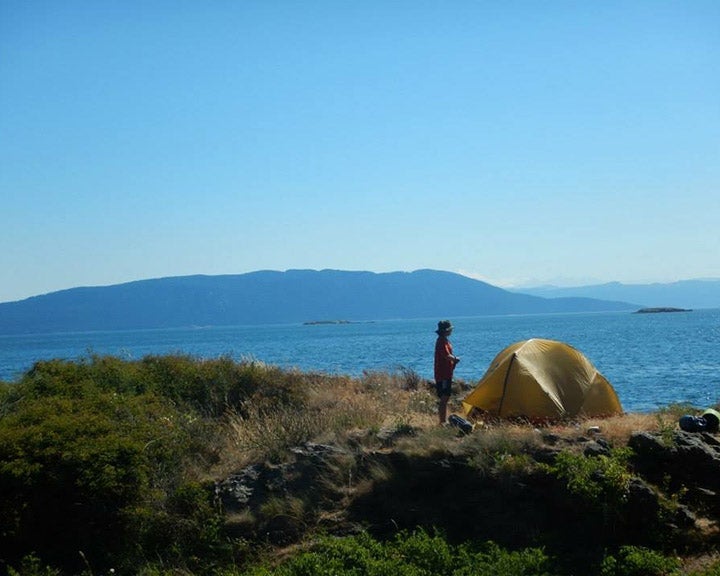“I guess…so long as the colors aren’t too, you know, girly. It just contributes to my gender dysphoria*…”
I was exchanging text messages with OUT There ���ϳԹ���s’ program alum Zander, regarding gear choices for his upcoming NOLS course. We had discovered that that men’s footwear we needed was not made small enough. This left us with choices only from the women’s line, and I was struggling to come up with color options that didn’t scream femininity. As a mentor to this young person, I was angry at the system but tried to debrief the situation in an optimistic tone. As a person, I was pissed. Yet again, the industry I love and have dedicated my entire career to was letting me down. And it was delivering a crushing blow to my former student.
The idea that gender is a performance, something we “do” every day was pioneered by feminist theorist Judith Butler. We take part in gender “performativity” by choosing the clothes we put on our bodies, the way we cut our hair, and how we carry ourselves as we walk through the world.
For folks whose gender identity and expression runs counter to our socialized assumptions, this performance is of profound significance, and in certain cases can be the difference between life and death. Anyone who has walked through a clothing store or flipped through a catalog can see that we have chosen as a society to gender everything we wear. The outdoor industry is no exception to this rule; even as we push against the “shrink it and pink it” mindset, women struggle to find clothes that aren’t traditional “girly” pinks and purples.
My exchange with my former student provides a powerful example of the ways in which our industry perpetuates stale and harmful assumptions of gender. This conversation is pertinent beyond the trans community.
Last year, Salomon was applauded when it created the Constellation ski series. Citing the size and potential of this untapped market amongst women backcountry skiers, the Constellation series was aimed at bringing these women in and ultimately profiting from them. Follow the trajectory of providing an untapped market with gear they love, and at the end you’ll find a growing cadre of outdoor enthusiasts and stewards. In the midst of conversations about shrinking profit margins and also the potential environmental disasters fueled by our Federal Administration, shouldn’t we be clambering for ways to cultivate more stakeholders?
If we take a step back a critically analyze our actions, namely our decision to continue to define the industry in “his” vs. “hers”, what will we discover? To quote Butler again, “gender is a kind of imitation for which there is no original…the act of elaborating itself is evidence that it is perpetually at risk…that it ‘knows’ its own possibility of becoming undone.” In other words, what are we doing and why? By continuing to codify our gear and clothing as we have, we are reinforcing the notion that only (cisgender, white) women wear purple (or some variation of teal) and men wear blue or black Gore-Tex. This in turn perpetuates the perceived assumptions the industry makes about who ventures outside and how. Through these actions, we are completely erasing the needs and wants of whole segments of the population that fall outside of these categories. While we may think that the multi-racial, queer urbanite isn’t a part of our target market, that’s simply not true. And it’s a short-sighted business move to ignore the growing population of queer people if we want to remain relevant the statistics on the future demographics of the United States begs to differ.
“You only trust those who are absolutely like yourself,” Butler said. “Those who have signed a pledge of allegiance to this particular identity.”
It’s time the industry takes this message to heart when it thinks about how to reach and include more diverse communities. We need more diversity of all types involved in the design process, not just to be more inclusive, but to enable more people to go outdoors and be comfortable and confident. Offering a less gendered color palette and fits for more body types is a smart investment and a first step toward organically growing the outdoor industry’s base. The industry needs to conduct deeper research, beyond its athletes. It needs to think about why clothing racks are sectioned off by binary gender and what assumptions your sales associates make about customers.
If you truly embrace diversity and think outside of the box, you make us feel welcomed and represented, and we will purchase your products.
If the industry wants to continue to protect wild places, and make money off a growing customer base, the clothes and gear we make, through colors, patterns, sizes, and cuts, must be reflective of more than one archetype.
*Gender dysphoria is the feeling that one’s biological sex and gender identity are not aligned. Zander, a trans male teen, often finds that men’s clothes don’t fit him as well as women’s clothes—yet women’s apparel is decidedly feminine, thanks to colors and patterns our society has gendered as strictly female.
Elyse Rylander is the founder and Executive Director of OUT There ���ϳԹ���s. OTA is a Puget Sound based non-profit whose mission is to cultivate leadership and build community for queer young people through adventures outside.


